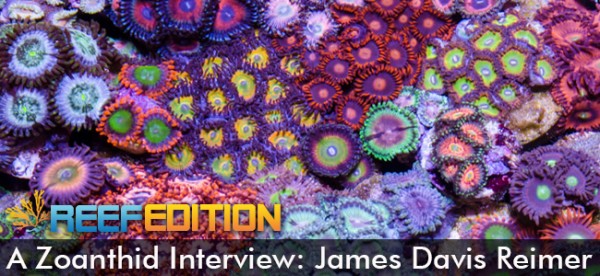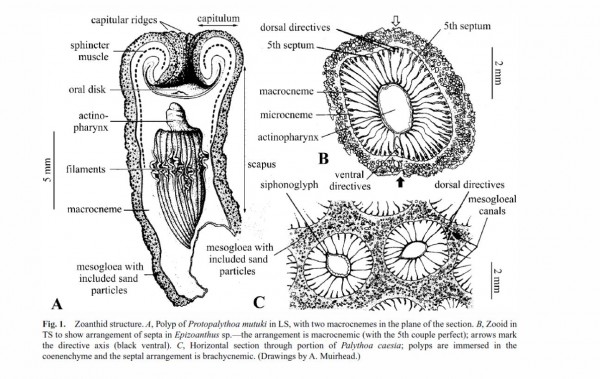A Zoanthid Interview: James Davis Reimer

By Josue Matias
The students and staff at Nova Southeastern University (NSU) Oceanographic Center (OC), Dania Beach, FL, are engaged in several studies of marine life. For example, they are conducting studies on issues such as the invasive lion fish and how to eradicate them and Florida hard corals, why they’re dying, and ways to replant them in our ocean. In 2014, I was asked to help some students with some tests they were doing to determine why zoanthids were dying. As part of that effort, I did considerable research. In my studies, Davis Reimer’s name kept showing up, so I decided to track him down and ask him a few questions about zoanthids. What follows is some of that conversation:
Q) Do you have any documentation on zoanthid anatomy?
A)There are many scientific papers on zoanthid anatomy out there. Check out figure 1 in Ryland & Lancaster this is a great figure for morphology.
Q) How many types of zoanthids are there? Commonly people refer to small close together polyps as zoanthids; bigger, longer stem polyps as palythoas; larger, slimy versions as protopalythoas; big green polyps as button polyps; and the really big polyps as cinnamon palythoas.
A) Basically, the aquarium field uses common, not scientific names. These names really have no meaning to scientists. For example, some but not all people seem to often confuse zoa, zoanthid, coral, paly, etc and base these on some common external features. While the basic ideas of identification are generally not bad, in science we would say “Zoanthus sp.” (never abbreviate) for this genus only, “zoantharian” to refer to all types in all groups, never use “coral” but could use “hexacoral” as Hexacorallia includes the order Zoantharia, but corals are usually Scleractinia, and “Palythoa sp.” for this genus. In science it pays to be exact, so this is the source of one gap in understanding.
By types, again, a general term. If you mean morphotype, then the sky is the limit. But I am assuming you mean number of species. In this case, there are still different numbers. We want to accurately know the number of species in the world to estimate biodiversity, but the names of species themselves follow the ICZN and taxonomic rules. So, for now, we usually look at WoRMS or other online scientifically checked lists (nomenclators) to get some numbers.
For Zoanthus and Palythoa, there are more than 100 names in the literature, but how many are actually species, this remains unknown, but I think much lower. You could check out some papers on this matter like Burnett et al. 1997, Reimer et al. 2004, Hibino et al. 2014.
Q) Do you use particular zoanthid color to determine a name?
A) Colors are not only a product of DNA but also environment. Thus, many colors are not trustworthy of being used for identification of zoantharians. Sometimes colors are, sometimes they aren’t, but we have to test and examine each characteristic. Generally, although we may use colors and gross appearance in the field, we try to use less-variable characters. The problem with Zoantharia is often not many characters are available (nematocysts, tentacle numbers, sizes of polyps), and even the ones that are available are variable and may even overlap between different species. Thus, DNA comes in handy.
Q) How do you scientifically differentiate them?
A) We use molecular and morphological data, along with locality/distribution, and compare with all past species described already.
Q) Zoanthids and the collection of this coral is very popular in the aquarium hobby. Do you follow the U.S. zoanthid “craze?”
A) A bit, but not too much.
Q) Do you personally know any zoanthid names?
A) I often use morphotype IDs in the field, but other than that, I guess the answer would be generally “no” or “not much.”
After reading some of his papers from as far back as the early 2000s it blows my mind at how amazing zoanthids are and how little we know about them. For example, in some of the papers I came across there have been temperature tests and in temperatures as low as 60 F zoanthids don’t grow but they don’t die either. In some of the other studies scientists go out to sea and count zoanthids during the different seasons and observe that colonies with 200+ polyps diminish to as little as 50 when seasons change.
How many of us have had beautiful, growing zoanthid colonies diminish over time to small frags? It makes me wonder how the results of these studies come in to play in our aquariums. I have also read studies on how some zoanthids were observed growing only 1 m from the surface It’s likely that lighting at the surface is more than 1,000 par! And we sometimes wonder why we can’t keep a certain zoanthid morph alive!
How helpful would it be if coral collectors around the world would document the specifics of factors such as par intensity, temperature, water flow rate, and water chemistry of the collection areas for each individual types of coral?
If you have any other questions to ask James Reimer you can send me a message at Reef2Reef here.
For more questions and answers about zoanthids please visit our Zoanthid Forum here.
Author
Josue Mathias is . . . . .


Leave a Reply
You must be logged in to post a comment.